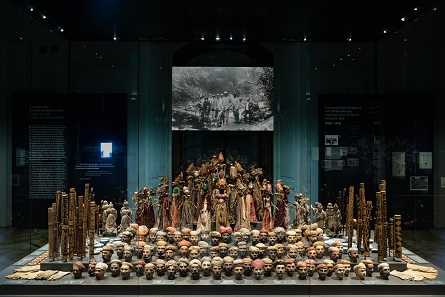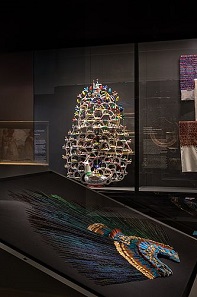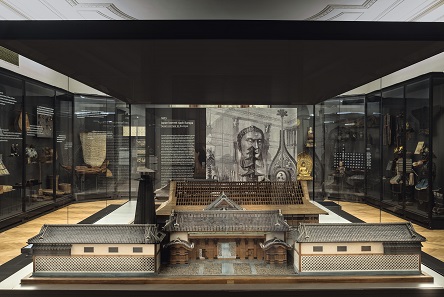November 23, 2017 – After three years of reconstruction the time had finally come: On October 25, 2017, the new Weltmuseum Wien reopened its newly-installed permanent galleries and several special exhibitions. The new Weltmuseum Wien presents itself as a venue for connecting cultures and people in unique fashion. As such, the museum is dedicated to the cultural diversity of humankind and strives to document the diverse historical ties between Austria and the world in its collections from all around the globe.
View inside the new permanent exhibition
As the very heart of the new museum, the permanent exhibition has been redesigned from the ground up. Strung together like a chain of pearls, the series of stories told in the fourteen galleries feature the core of the permanent exhibition combined with contemporary interpretations. On show is a total of 3.127 objects as well as numerous photographs. The installation reveals many, frequently surprising connections between Austria and the world. Visitors are invited to rediscover the world-famous collections that include the “penacho”, the celebrated ancient Mexican feathered headdress, the collection assembled by Captain James Cook (1728-1779), and the objects brought back by Johann Natterer (1787-1843) from his expedition to Brasil.
View inside the room “Stories from Mesoamerica”.
Stories from Mesoamerica
The first written evidence of Mexican objects in Austria is found in the inventory of the Chamber of Art and Wonders at Ambras Castle in 1596: the list included those feather objects that are known all over the world today. The artefacts of Ambras Castle can be traced back to the 16th century and the earlier pre-Columbian time. Further treasures from the colonial period were once found in the Habsburgs’ treasuries and chambers of curiosities in Graz, Vienna, and Prague. When Maximilian of Habsburg was the emperor of Mexico (1864–1867), extensive archaeological collections were assembled that the Museum was able to acquire in the late 19th century.
View inside the room “Benin and Ethiopia”.
Benin and Ethiopia: Art, Power, Resilience
The West African kingdom of Benin and the Ethiopian Empire in the east of the continent were already known to Europeans in the late 15th century. Both engaged in intense exchange first the Portuguese and later with other European envoys and merchants. Aside from these historical intersections, both states feature a series of other remarkable parallels that ultimately allowed parts of their cultural heritage to end up in Vienna.
View inside the room “1873 – Japan comes to Europe”.
1873 – Japan comes to Europe
The World’s Fair in Vienna in 1873 marked an important moment in the history of Japan. After being forced by external pressure to open up, and after an interior restructuring of the country, Japan found itself in turmoil. Following the abolition of the old feudal system in the course of the Meiji Restoration, Japan endeavored to present itself in Europe as a modern state. The central piece of this gallery is one of the largest items exhibited in the Japanese pavilion at that time, the model of a daimyo residence of the Edo period (1600-1868).
Information on the Weltmuseum Wien can be obtained from its website.
To have a look at the special exhibitions currently on display, click here.
Highlights from the new permanent exhibition can be viewed here.








